Archive for the 'Uncategorized' Category
September: Welcome to Apple Season
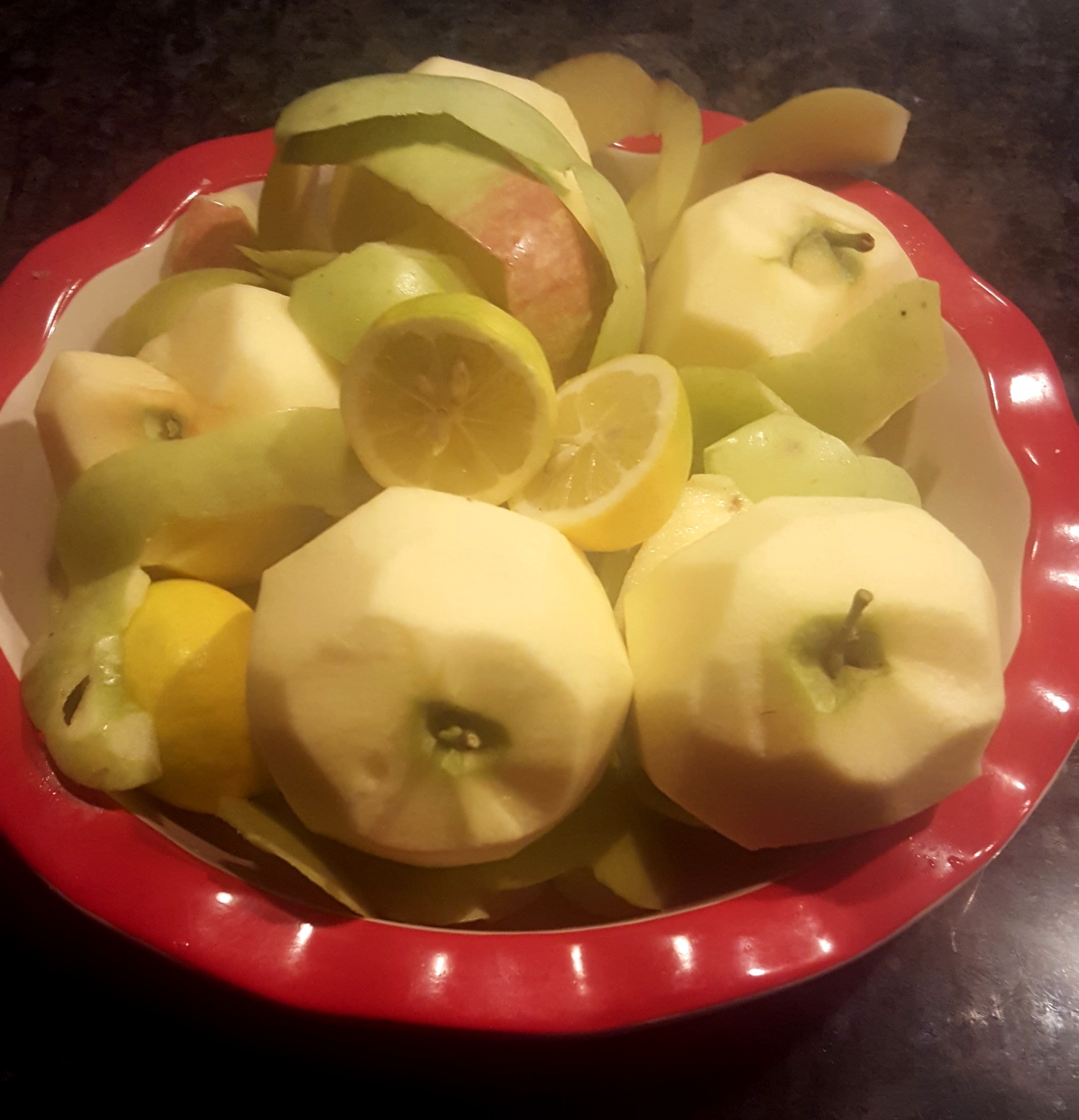
Apple season traditionally extends from Labor Day to Thanksgiving, depending on what part of the country you live in. That noted, some orchards have varietals of apples ripening prior to Labor Day. Some apples might be ripe by mid-summer while others need a longer season and come to harvest later in the fall. In Washington state as here in northern California, apple season runs from roughly from August to November.
In autumn, local orchards offering a “you-pick” option often close when the weather gets cold. But picking your own apples offers a great family outing and at a cost-savings. Think about the grower facing labor costs for picking, storing, and shipping the apples to market. Those costs can add up and some of it gets passed on to the consumer. Buying a few pounds or a bushel basket of apples that you pick yourself will save you some of your hard-earned cash.
I grew up on a farm in central Missouri but my grandparents did not have apple trees. In the fall, we would drive to a local orchard in the country near where we lived and pick bushel baskets of apples. My Grandma Rosie would turn the fruit into apple butter, applesauce and sliced apples preserved in a hot water canner for winter suppers. And don’t even get me started on her apple deserts that included cobbler, crisp, crumbles, cookies, fritters, pandowdy, and apple pie.
If you happen to have a pound of apples on hand for cooking or eating fresh, why not try making them into this simple apple fritter recipe for a breakfast (or anytime) treat?
Recipe for Country Apple Fritters
Ingredients:
1 pound apples
1 cup flour
1 pinch salt
1 egg
2/3 cup milk
oil for frying
granulated sugar for dusting fried fritters
Directions:
Whisk together the salt and flour in a large bowl. Make a well and add the egg. Drizzle in the milk and whisk to combine ingredients. Set aside the batter for about an hour while you prepare the apples.
Peel and core the apples. Cut into uniform-size rings no more than 1/2-inch thick. Heat enough oil to cook one or two rings at a time. When the oil is hot, use a skewer stick to hold the apple ring while you dip it into the batter. Fry each fritter to golden brown. Remove and drain on a paper towel and dust with sugar. Serve immediately.
Enjoy reading about farm topics? Check out my Henny Penny Farmette series of cozy mysteries. Chocked full of farm trivia and helpful advice for keeping chickens and bees and growing heirloom fruit and vegetables, all three novels are available online and in bookstores everywhere.
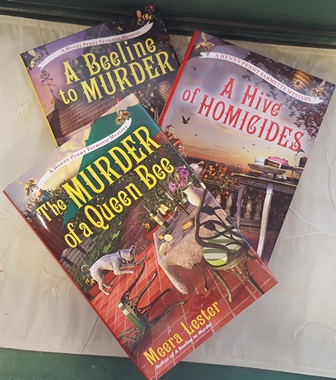
A Beeline to Murder–When the town’s celebrity pastry chef is found dead, Abby Mackenzie (a former cop who supplies the chef with her organic lavender honey) discovers the chef’s secret private life suggests the killer might be local.
The Murder of a Queen Bee–The botanical shop owner and friend of Abby Mackenzie doesn’t make it to a party where she’s the guest of honor. Her death leads Abby to speculate that friends of the deceased might be hiding her killer.
A Hive of Homicides–Abby attends a vow-renewal party of her best friend and is an ear witness to the murder of the newly arrived re-married couple. The husband’s philandering past establishes a pool of suspects but Abby is convinced that there’s more to the murder a scorned lover’s revenge.
Enjoy Seasonal Fruit Year-round
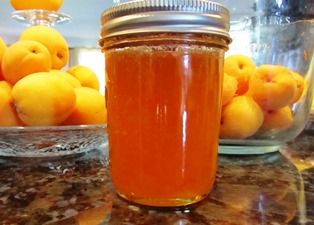
In the Bay Area, strawberries, blueberries, and early varieties of plums ripen in the spring. By the start of summer, a lot of stone fruit is available. Look for apricots and peaches and later varieties of plums during early June through July. Find peaches and nectarines by mid-August.
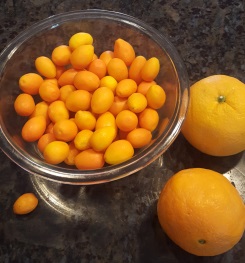
for winter marmalade
The end of the stone fruit heralds the arrival of late-summer pears. Local suppliers offer these fruits at farmers’ markets and to stores throughout the harvest period so buyers can be assured of fruit quality and freshness.
To preserve your favorite summer stone fruit, you have several options. Hot-water canning supplies come in handy for preserving fruit into jam, jelly, marmalade, and conserve. A dehydrator produces dried fruit and leathers. Finally, some fruits can be made into jam or marmalade and refrigerated for use over a week or two or frozen.

As summer nears its end, look for a large variety of pears and persimmons to show up on store shelves. Then, as the winter holidays near, citrus (oranges, kumquats, lemons, and limes) begin to ripen and can be preserved into a soft spread such as a conserve, jam, or marmalade.
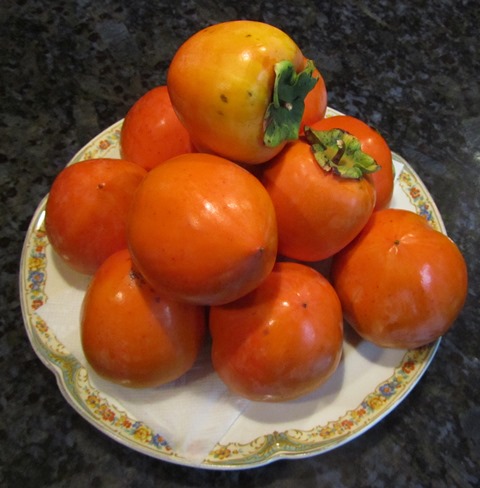
If country living topics interest you and you enjoy a good mystery with recipes and tips for keeping chickens and bees, check out my Henny Penny Farmette series of cozy mysteries, informed by my real-life farmette experiences.
The novels include A BEELINE TO MURDER, THE MURDER OF A QUEEN BEE, and A HIVE OF HOMICIDES. All are available online or wherever books are sold.
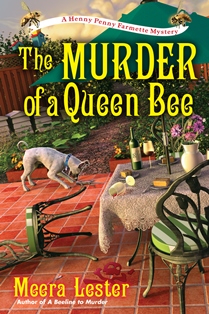
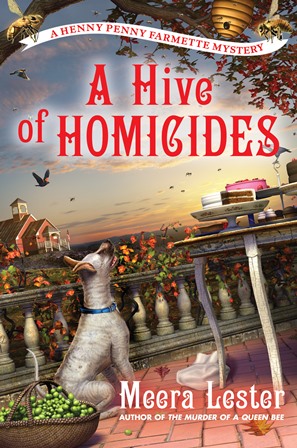
Four Reasons to Buy Bare-Root Plants
Mid-February marks the beginning of bare-root season in the Bay Area. Growers ship roses, fruit trees, grapes, and berries in late January through February and March to local nurseries and DIY garden centers. By April, often sales of unsold bare-root plants begin. There are at least four good reasons to buy bare-root plants before spring officially arrives.

- When you buy bare-root trees, berries, grapes, and other plants in late winter (here in the Bay Area), you’ll pay less for them than you will if you wait until the start of spring. The purchase price increases later in the season. When the plants begin leafing out, nurseries will place unsold bare-root plants in pots. Potting an unsold plant involves extra labor as well as the costs for the pot, soil and amendments, mulch, and possibly stakes. Those costs are passed to the shopper.
2. It’s easy to place a bare-root tree right into your garden before its sap is flowing. When it is still “asleep,” it’s not as susceptible to cold and and won’t need as much water as it will when the weather is warm, the plant has leafed out, and the roots are growing and spreading.
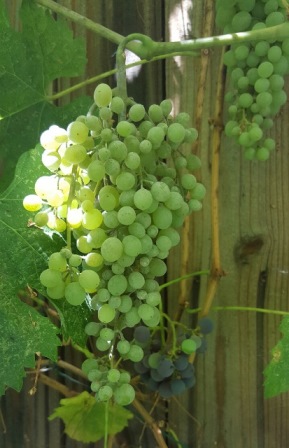
varieties of bare-root grapes.
3. Bare-root buys you time. If you are still planning your garden, you can “heal in” a bare-root plant until you are ready to put it in your garden. You just need to excavate a trench in which you temporarily place the bare-root plant. Mound soil over the roots and water. Let the plant rest until you prepare the permanent planting hole.
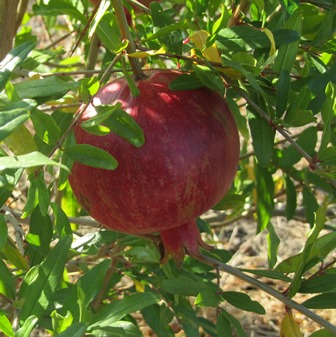
popular because they remain small and fruitful for years.
4. You have an opportunity you won’t get again to inspect the health of the root and its growth. With a bare-root plant, the roots can be examined for problems such as decay or damage. Using sharp pruning shears, you can cut away problem issues. When you buy an already potted plant, you won’t have this option.
Take a moment to visit your local plant seller, nursery, or DIY center to see what plants are available right now. Enjoy the season.
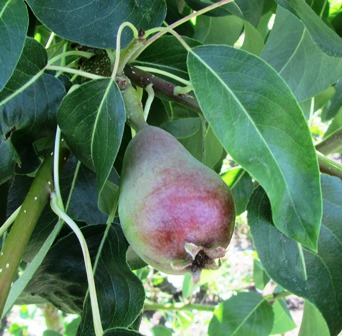
and after three years is producing dozens of late summer pears.
If you enjoy reading about country living topics, check out Meera Lester’s Henny Penny Farmette mystery series. Besides an entertaining mystery, each book includes delicious recipes, strategies for growing heirloom vegetables and fruits, and tips for keeping chickens and bees. These novels and her nonfiction self-help and wellness books are available online and everywhere books are sold.

Checklist for Bay Area Fruit Trees
In the Bay Area, January through February are optimal months for checking on your backyard fruit trees. After the leaves have dropped and the scaffolding is exposed, winter/early spring pruning is a lot easier.
The first months of the year are also the best times to feed, do orchard cleaning, and deal with overwintering pests.
Citrus trees, especially, benefit from a mid-winter check for magnesium or iron deficiency, indicated by yellowing of the leaves. You should also examine the trees for pests such as snails, ants, aphids and Leafminer. It’s also a good time to plan on how to protect your citrus against frost.
Handy Checklist
- Prune apples and pears for structure in late winter or early spring. Check for fire blight (look for a shepherd’s hook and the appearance of fire staining on limbs and the trunk). Remove wood 8-12 inches below infected areas and any obvious cankers. Feed when the trees leaf out.
- Check almonds, apricots, cherries, and plums for pests such as aphids, scale. Treat as necessary. Instead of pruning apricot and cherry trees in mid- to late winter, wait for late summer/early fall as winter rains can spread infections of Eutypa fungus that causes limbs to die back.
- Practice ongoing winter cleanup. Sanitation is of paramount importance in preventing pests infestations and fungal diseases. Regularly move fallen leaves, twigs, fruit, and other debris from the garden and orchard.
- Check citrus for infestation of Citrus Leafminer (look for brown lines and webbing on the leaves along with curling of the leaves. Treat the tree with Captain Jack’s organic fruit and vegetable spray. Application needs to be repeated every two weeks, especially when the tree is producing new growth, but no more than six times per season.
- Citrus leaves that are yellow or mottled with yellow when they should be bright green may have a magnesium or iron deficiency. Correct the chlorosis by applying iron. Prune citrus in mid-to-late March (here in the Bay Area).
___________________________________________________
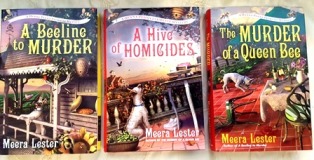
Enjoy reading about farm topics? Check out my Henny Penny Farmette series of cozy mysteries. Chocked full of farm trivia and helpful advice for keeping chickens and bees and growing heirloom fruit and vegetables, all three novels are available online at Amazon and Barnes and Noble bookstores and in brick-and-mortar stores everywhere books are sold.
Persimmon Trees Are Productive, Pretty, and Easy to Grow
The Japanese Hachiya persimmon is a small to medium-size tree that packs a lot into a landscape. In autumn, the tree’s large, leathery leaves turn orange, red, and yellow, reminiscent of the gorgeous fall colors of trees growing in the east and midwest. Of course, mine are growing on my farmette in Northern California.

After a persimmon tree sheds its canopy of leaves, its scaffold continues to provide visual interest in the garden. Globes of orange fruit hang on for weeks, looking a lot like Christmas ornaments.
An easy way to eat a fresh Hachiya persimmon is to first wash the soft, ripe fruit. Then, slice off the top, scoop out the pulp with a teaspoon, and enjoy a mouthful of the flavorful fruit that resembles sweet pudding. A word of warning about biting into unripened fruit. It is extremely astringent and unpalatable.
Growing the Hachiya persimmon is relatively easy. These trees aren’t fussy about soil and don’t need a lot of watering. In dry climates, give the tree a weekly soaking during its growing season. Persimmons are relatively disease-free and don’t attract a lot of pests.
Train them to grow into a vase shape during the first three to five years. Be mindful that the fruit is produced on new wood. However, a severe pruning will reduce your fruit crop. Once the tree is established, do your pruning during the tree’s winter dormancy to remove dead and diseased branches or those that are crossing other branches.
If you enjoy reading about gardening and other country living topics and also enjoy a good cozy mystery, check out my Henny Penny Farmette series of novels. These novels also include wholesome recipes, tips for keeping chickens and bees, and gardening info based loosely on my experience as the real Henny Penny Farmette proprietress. The novels are available online and everywhere books are sold.
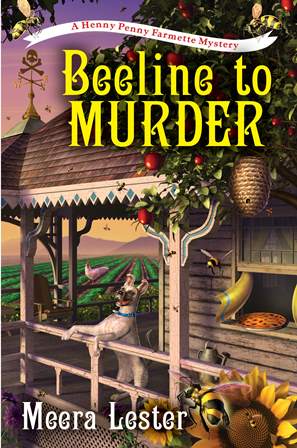


Available from the publisher, Kensington NY, Barnes and Noble, Amazon, and other online and traditional bookstores everywhere.
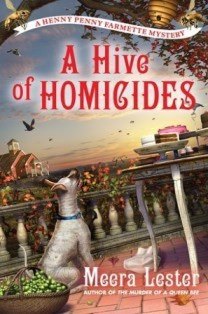
Enjoy reading about farm topics? Check out my Henny Penny Farmette series of cozy mysteries. Chocked full of farm trivia and helpful advice for keeping chickens and bees and growing heirloom fruit and vegetables, all three novels are available online and in bookstores everywhere.
Get the three-book series of cozy mysteries with elements based on the real Henny Penny Farmette
These novels include elements based on the real Henny Penny Farmette
A Beeline to Murder–When the town’s celebrity pastry chef is found dead, Abby Mackenzie (a former cop who supplies the chef with her organic lavender honey) discovers the chef’s secret private life suggests the killer might be local.
The Murder of a Queen Bee–The botanical shop owner and friend of Abby Mackenzie doesn’t make it to a party where she’s the guest of honor. Her death leads Abby to speculate that friends of the deceased might be hiding her killer.
A Hive of Homicides–Abby attends a vow-renewal party of her best friend and is an ear witness to the murder of the newly arrived re-married couple. The husband’s philandering past establishes a pool of suspects but Abby is convinced that there’s more to the murder a scorned lover’s revenge.
How to Grow Garlic
In the Bay Area, September to late October is the optimum time to sow garlic for a spring harvest. Or, you can plant garlic in prepared beds in spring for an autumn harvest.
Get your garlic cloves into garden soil or containers before the first frost to ensure enough time during the rainy winter months for the bulb to grow. Watch for the appearance of its strap-shaped leaves.
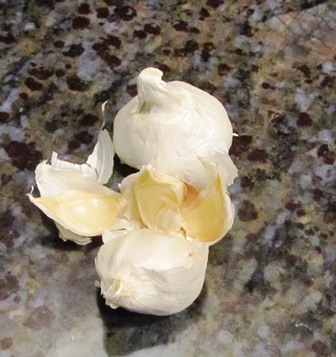
Why Grow Garlic?
Garlic is an ancient herb that adds a wonderful pungent complexity to a wide variety of culinary creations. In a kitchen garden, vegetable patch, or potager garden where herbs and vegetables grow alongside berries and fruit trees, garlic works as a beneficial companion plant because its pungent odor acts as repellent for many common garden pests.
Garlic has medical uses, too. In many parts of the world, the herb has been used as treatment for hypertension, bronchial inflammation, fungal skin issues, and high cholesterol. Modern science makes note of garlic compounds as having anti-inflammatory, anti-fungal, and anti-bacterial properties as well as benefiting the immune system.
Choose Softneck or Hardneck Garlic
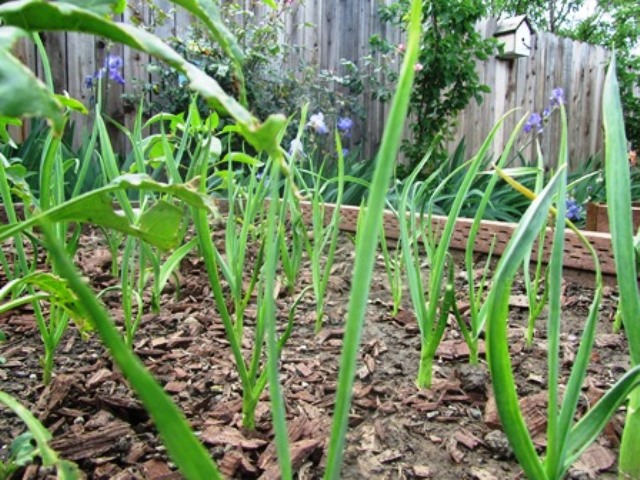
Garlic falls into two main types: the shorter, softneck variety and the long hardneck type that is often braided. Gardeners can choose from dozen of varieties in each type. Local DIY garden centers or nurseries generally offer garlic during the optimal times for planting it. Notably, elephant garlic, while bearing the name of garlic, is not garlic at all but rather a relative of the leek family whereas true garlic is related to the onion (Allium) family.
Following the following six simple tips can ensure success at growing garlic as a kitchen staple.
- Plant each clove (pointed side upward, round base downward) in full sun, about 4 inches deep and 4 to 6 inches apart. Space the rows 6 to 8 inches apart. Use well drained-loamy soil to grow your garlic.
- Grow the garlic in raised beds with soil amended with compost and fertilizer if you have clay soil since clay is unsuitable for growing garlic. The point is to plant this herb in a nutrient-rich, well draining but moisture-retentive soil.
- Water well when planting; do a weekly watering thereafter. For autumn planting, the Bay Area’s rainy season might provide enough water to keep the herb happy without extra watering through winter, but it’s no guarantee. Drought conditions have prevailed through the rainy season of past years and then there were 17 atmospheric river storms in 2022-2023. Your best bet is to keep checking on the garlic until it is well established.
- Harvest any garlic scapes, the long, green flowering stems of hard-neck garlic, before they flower. The garlic bulbs will be significantly smaller if the scapes are permitted to flower.
- Control weeds. If allowed to grow, they can take over your garlic plants.
- Keep an eye out for pests like dry bulb mites (watch for stunted, twisted leaves and galls indicating that these wormlike pests are present). Other pests include leaf-miners, parasitic wasps, and garlic bloat nematodes (roundworms that feed on the plant, rendering the bulbs soft, brown, and unusable).
Enjoy reading about gardening and other country-living topics, check out my cozy mystery novels. They are chocked full of tips on gardening, beekeeping, and country cooking as well as offering a great mystery in the style of Agatha Christie.

Five Plants that Benefit from Companion Plants
It’s a simple concept. Grow specific plants in close proximity to certain other plants to repel bugs, attract good pests, suppress weeds, provide shade, improve yields, and generate better soil. Whether you sow seed for a warm- or cool-season crop, consider putting in some companion plants nearby for better overall results.
TOMATOES

Onion, basil, spinach, parsley, carrot, basil, and celery make great companions for tomatoes. Marigolds deter beetles and corn worms and repel harmful nematodes that can cause nutrient deficiency, stunting, and plant death.
CORN
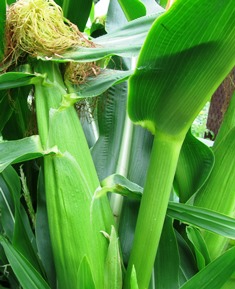
In Native American agriculture, three vegetables–squash, corn, and pole bean–constitute the “three sisters.” These vegetables benefit greatly from being planted together. The corn stalks provide structural support for the beans to climb. Squash leaves grow large, so they keep down weeds, help retain moisture, and provide shade for the small squash that forms off the blossom.
BEETS
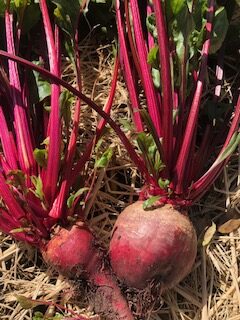
Beets are a superfood–they are low in calories and high in vitamins and minerals. Sow seed for this cool season crop in spring or during late summer for a fall harvest. Onions, garlic, cabbage, shallots, leeks, and lettuce make great companion plants for beets.
PEPPERS
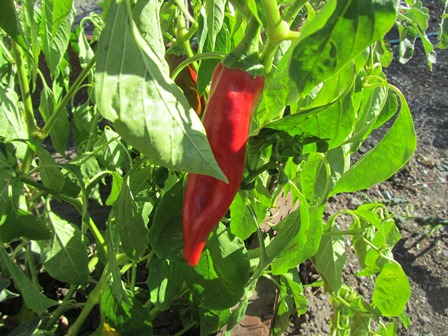
Peppers are in the same plant family as tomatoes and eggplant so avoid planting them anywhere near where you have tucked in tomatoes and eggplant because they will attract the same pests and diseases. Instead, choose herbs such as garlic, dill, parsley, and cilantro; and flowers, including marigolds and nasturtiums, as companion plants. In particular, low-growing cilantro attracts beneficial insects and repels spider mites and aphids while basil repels mosquitoes and thripes.
STRAWBERRIES
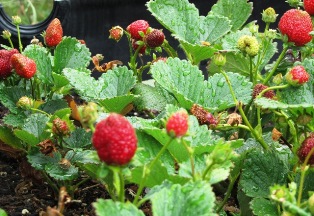
,
Strawberries benefit from companion plants belonging to the Allium family–chives, leeks, onions, scallions, and garlic. These beneficial companion plants are believed to thwart a particular fungus–fusarium wilt–that can infect strawberries. Slugs and snails as well as aphids are repelled by the pungent odor of those specific members of the Allium family.
Love gardening? Check out my cozy mysteries informed by my gardening on the Henny Penny Farmette. I garden with open-pollinated plants and keep an orchard of fruit and citrus trees. You can find A BEELINE TO MURDER, THE MURDER OF A QUEEN BEE, and A HIVE OF HOMICIDES along with more than two dozen nonfiction books that I’ve written online and wherever books are sold.

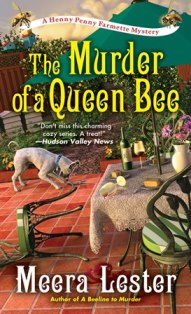

the catalyst for ex-cop-farmer Abigail Mackenzie
Find me on Facebook, LinkedIn, and Instagram and on my publisher’s page at Simon and Schuster.
Cultivating Beets for Good Health
Want to reduce inflammation, lower your blood pressure, increase your fiber intake, and reduce your LDL cholesterol by eating just one food? Try beets.
This jeweled-hue root vegetable, perfect for borsch, can be made into a smoothie, tossed into your homemade pesto, or served up as a salad, snack, or side dish. Beets contain phytonutrients or compounds in plants that contain cancer-fighting and anti-inflammatory properties.
To be specific, beets are rich in betalains and nitrates. The former has potent antioxidant powers while the latter reduces inflammation by removing from your bloodstream those compounds that are known to be inflammatory and harmful. Consider, too, that the purple-red juice (known for staining surfaces) can be used as a natural food coloring.
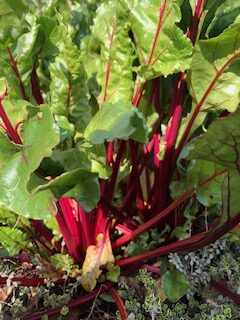
of the beet root are edible and nutritious
Cultivating Beets
Beets grow best in fertile, well-draining, loose soil (no rocks or weeds) with a slightly acid or neutral pH. Work into the soil plenty of compost before planting. They need plenty of room for the root to plunge and for the beet to form and grow.

A good soaking of beet seeds 24 hours before planting will expedite their germination. Alternatively, soak the seeds for one-half hour in warm water and then plant. Throughout the growing season, water the beets when the soil is dry.
Beets need about six hours of sun to thrive but will accept some shade. They are a cool season crop, meaning that they will thrive in temperatures hovering around 55 to 60 degrees Fahrenheit. Think of the seasonal temperatures of spring or fall.
Some heirloom, non-GMO seeds will produce a variety of beet colors such as deep purple or yellow. Sow your seed every three weeks in early spring for a continuous crop of beets that will bestow wonderful health benefits.
If you enjoy reading about country living and gardening topics, check out the Henny Penny Farmette series of cozy mysteries. They are based in part on my real life on the farmette and are chocked full of tips on keeping bees, caring for chickens, growing heirloom vegetables, and cooking delicious recipes.

A Rose Bush for Your Valentine?
If your sweetheart is a gardener, why not give a gift that keeps on giving? Instead of a single rose or a bouquet, consider giving a bare-root rose bush. A plethora of plants are arriving in garden centers now.
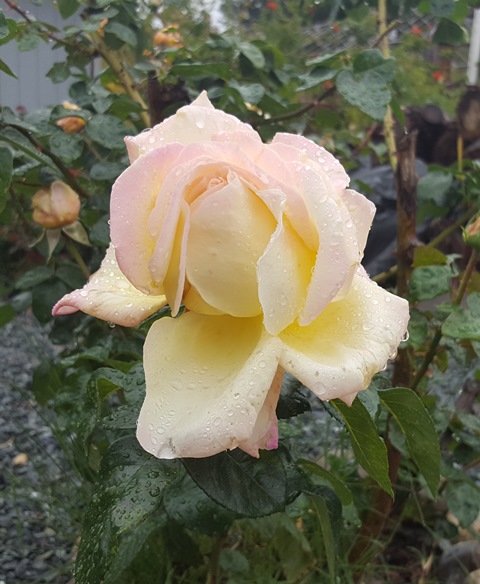
Many modern roses have been bred to bloom repeatedly throughout spring, summer, and fall, even into December in milder climates. With gorgeous single buds on tall stems or dazzling sprays of blooms, roses are the perfect cut flowers for indoor bouquets.
With the traditional “lover’s” day just around the corner, now is the time to decide on what type of rose bush to give your valentine. Bare-root season is the best time to purchase rose bushes. In a couple of months prices go up as unsold roses are re-potted in containers of soil with nutrients.
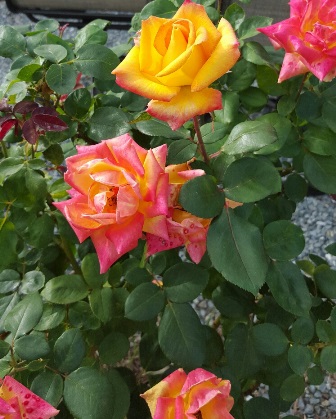
well-known “Ketchup & Mustard” floribunda
At the most basic level, roses are classified into three main categories: wild roses, old garden roses bred before 1867, and new roses bred or hybridized for modern gardens for fragrance, bloom size, color, and other desirable characteristics.
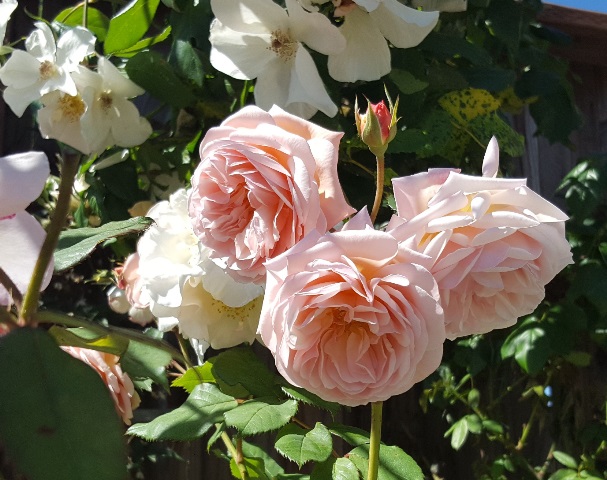
Before you buy, consider what characteristics you would like in a rose and choose a type that matches your purpose.
Modern varieties have been cultivated to produce roses to repeat bloom, bloom as single buds, or bloom in sprays. Some are fragrance-free; others offer a heady scent. Many roses have prickles (sometimes called thorns although technically they are not). The blooms of roses vary in size, shape, and number of petals as well as color. Some have a single color. Others display two or more colors as the blooms open and age.
Consider how much space your sweetie might have in his or her garden for growing the rose. Climbers need support like a wall, fence, or a trellis. Certain roses aren’t fussy about soil, other cultivars have specific needs. Be informed before you buy. Be sure to read the rose label for information about the cultivar.
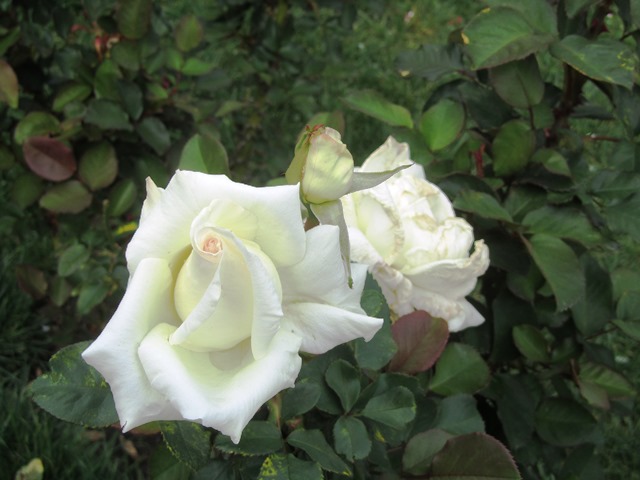
If you enjoy reading about gardening and country living and also love a good story, check out my Henny Penny Farmette series of cozy mysteries. All are available online and wherever books are sold. They include, A BEELINE TO MURDER, THE MURDER OF A QUEEN BEE, and A HIVE OF HOMICIDES.
Caring for Your Backyard Fruit Trees
The dormant period between winter solstice and the bare-root season of late winter/early spring provides a great opportunity to evaluate a fruit tree’s health. Although trees should be checked throughout each season, the dormant period is a great time to take stock of problems and initiate remedial action before the trees break bud.
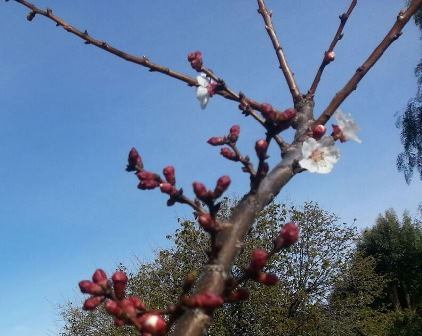
Cherry trees, in particular, can be infected with powdery mildew, root rot, aphids, fruit flies, bacterial canker, and fungal leaf spot
APHIDS
Pests can survive in the crevices of fruit tree bark or any infected leaves on the ground. If your apple trees, for example, were infested with aphids or scale last season and were left untreated, it is likely you’ll have the problems again this spring if the problem is left untreated.
There are a few natural ways to deal with aphids that suck sap on the underside of leaves. Try spraying with an organic neem oil (made from the seeds of the neem tree) that makes feeding or moving by the aphids impossible, causing death to the pests.
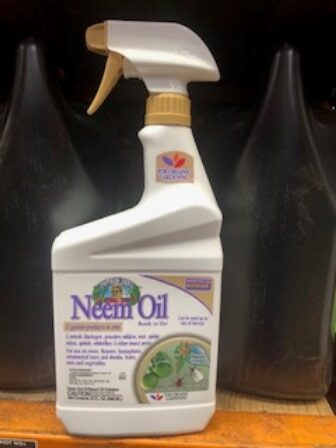
treatment for aphids and mites and can
be used on roses, fruits, and vegetables
An effective homemade treatment is to mix up a spray of 3 teaspoons of soap in a gallon of water. The pests die when they lack food. Spraying them off the tree deprives them of their food source–sap. Another option is to purchase and release ladybugs, natural predators of aphids. A third option is to plant alyssum at the base of your tree. The alyssum plants attract hover flies, a beneficial pest that’s a voracious eater of aphids.
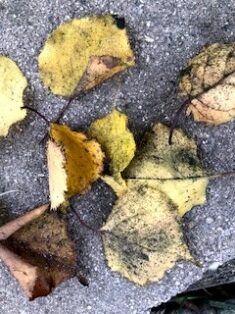
on through autumn
LEAF CURL
Peach leaf curl doesn’t just infect peaches. It can also affect almonds, pears, plums, and nectarines. At its most basic level, leaf curl is a stress of the tree caused by the fungus, Taphrina deformans.
Infected tree leaves become deformed. The leaves develop bulges that look like red blisters and the leaf edges turn inward. Green leaf color becomes yellow.
The fungal spores overwinter on the twigs. When the weather is warm and the outside air is humid, the fungal infection rapidly spreads, especially as buds swell and open. The fungus enters leaf tissue and causes hypertrophy (swelling and distortion of the leaves). The spores develop and lodge in the buds and cracks and crevices. These need to be eradicated in the fall. When leaves drop, remove them and put them into garbage, never in your compost pile.
During an outbreak of leaf curl, gardeners can pick off infected leaves, but you don’t want to denude the tree. The most common remedy is spraying with a lime-sulfer or fixed copper fungicide in late autumn and again before the buds form in spring. However, fungicides and insecticides are toxic to bees. Check with your local garden center for recommendations of organic, non-toxic products used in your area.
Remember with any pruning to rinse your pruning shears in 70% rubbing alcohol, bleach, or other garden cleaning disinfectant formulated to remove any bacteria and fungus to prevent infecting other trees in your backyard garden or orchard.
POWDERY MILDEW
Powdery mildew is a fungal disease that infects over 10,000 plants, according to the University of Minnesota, including roses, peonies, ornamental grasses, and backyard fruit trees. The disease affects a tree’s leaves, buds, flowers, and stems.
Characterized by gray or white patches, powdery mildew is not difficult to detect. To treat powdery mildew, prune back affected parts of the tree and dispose of the cuttings. Improve air circulation to benefit remaining fruit trees (or plants that might be growing too close together).
A foliar spray made of one gallon of water, one tablespoon of baking soda, and a teaspoon of dish soap can be an effective treatment of powdery mildew if applied to all affected areas. Spray and wipe off the the area with a paper towel.
If you enjoy reading about gardening and other country living topics, check out my series of cozy mysteries. Each of the novels in the series is packed with delicious recipes, tips for keeping chickens and bees, and insights into growing heirloom plants. Along with my nonfiction health, wellness, spirituality, and travel books, the Henny Penny Farmette mysteries are available online and everywhere books are sold. –Meera Lester

The Murder of a Queen Bee, and A Hive of Homicides.
 Facebook
Facebook Goodreads
Goodreads LinkedIn
LinkedIn Meera Lester
Meera Lester Twitter
Twitter




